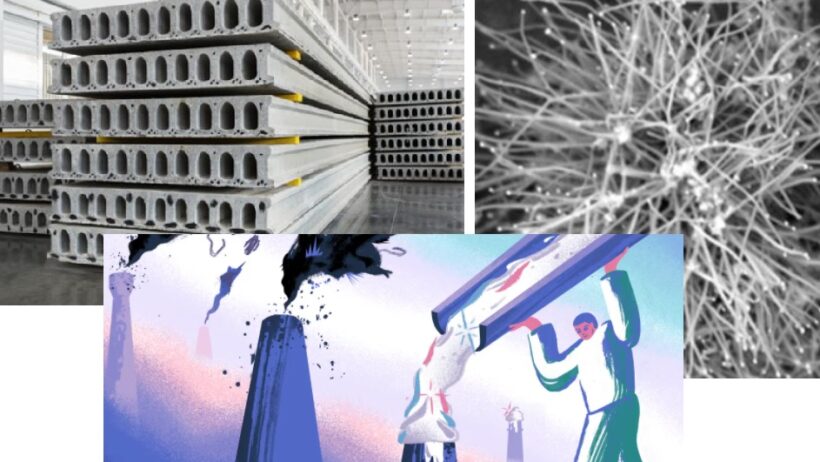Concrete is the cornerstone of modern construction, serving as the ubiquitous material for a myriad of structures—from residential homes to colossal skyscrapers. It is often hailed for its durability, versatility, and cost-effectiveness. But lurking beneath its solid exterior is a hidden threat: the substantial carbon footprint associated with its production. The question arises: does building with concrete significantly contribute to global warming? To unravel this complex issue, one must delve into the intricate relationship between concrete and climate change.
The journey begins with an understanding of concrete’s composition. Primarily made of cement, aggregate, and water, concrete is inextricably linked to the carbon cycle. Cement production is remarkably energy-intensive, accounting for approximately 8% of global CO2 emissions. The process involves the calcination of limestone (calcium carbonate), which, when heated to high temperatures, breaks down into lime (calcium oxide) and carbon dioxide. This one-two punch—emission from the fuel needed for heating, coupled with the chemical reaction—is responsible for the vast majority of cement-related emissions.
As urbanization accelerates, the demand for concrete skyrockets. The construction sector is one of the most rapidly growing contributors to greenhouse gases. Each year, billions of tons of concrete are poured worldwide, leaving a tangible mark on the planet’s carbon landscape. The sheer volume raises alarms among climatologists and environmental advocates alike. Every cubic meter of concrete signifies not just built structure but also a legacy of environmental impact.
To grasp the significance of concrete’s role in climate change, one must consider its life cycle. It is not merely the production of cement that impacts the environment; it extends to extraction, transportation, usage, and end-of-life disposal. The entire life cycle from raw material extraction to demolition incurs carbon costs. Aggregates are often sourced from quarries, which disrupt local ecosystems and contribute to erosion and biodiversity loss. This extraction process entails heavy machinery that further contributes to greenhouse gas emissions. Moreover, transporting these materials typically involves fossil fuel-powered vehicles, adding yet another layer of carbon to an already formidable footprint.
The environmental repercussions do not dissipate after the construction is complete. Concrete structures are notorious for their thermal mass, which can exacerbate urban heat island effects. The heat absorbed by concrete can elevate local temperatures, leading to increased energy consumption due to elevated air conditioning needs. The energy required to cool these structures often derives from fossil fuels—thus perpetuating a vicious cycle of emissions.
However, it is paramount to note that concrete is not inherently detrimental. Innovations in material science are paving the way for greener alternatives. Alternative cementitious materials, such as fly ash and slag, can replace a portion of the cement, thus reducing the carbon emissions during the production phase. Additionally, the advent of carbon capture and storage technologies presents a potential lifeline. These technologies capture CO2 emissions before they are released into the atmosphere, effectively mitigating the impact of production.
There is a burgeoning interest in utilizing recycled concrete as a sustainable building material. Reusing existing concrete not only diverts waste from landfills but also diminishes the need for new aggregates, thereby reducing both emissions and resource depletion. The process of crushing old concrete into aggregate for new mixes exemplifies how closed-loop systems can be implemented within the construction industry. By viewing concrete as a renewable resource rather than a single-use product, the environmental burdens can be significantly alleviated.
Additionally, the development of bio-concrete incorporates living organisms into the mix, fostering a symbiotic relationship with the environment. These innovative materials harness natural processes, such as photosynthesis, to sequester carbon and promote environmental health. By re-engineering how concrete interacts with its surroundings, it may be possible to reverse some of the damage historically inflicted on the planet.
The architectural community is also responding to the climate challenge. A shift in design philosophy towards sustainability and resilience is gaining momentum. Concepts such as “design for disassembly” encourage structures that can be easily dismantled and repurposed, significantly enhancing the life cycle of building materials. By encouraging not just the use of less concrete but rather strategic utilization of diverse materials, the construction industry can aspire towards a future that prioritizes environmental stewardship.
Governments and regulatory bodies are beginning to take note. Policies encouraging sustainable practices are emerging globally, with many countries committing to net-zero targets. These frameworks play an essential role in revolutionizing building codes and incentivizing sustainable material use. Recognition of embodied carbon—the total emissions associated with a material’s production and use—is becoming integral in legislative discussions. By implementing carbon accounting measures, transparency in construction can be achieved, allowing stakeholders to make informed choices that mitigate climate impacts.
Ultimately, the question of whether building with concrete contributes to global warming can be answered with a nuanced understanding of its relationship with the environment. While concrete’s role in climate change is substantial, it also presents unique opportunities for innovation and sustainability. A collective effort towards responsible production, consumption, and recycling of materials is paramount. Embracing innovative technologies and changing paradigms in construction could transform concrete from a climate villain into a climate ally. To navigate the intricacies of building a sustainable future, we must rethink our approaches, question our choices, and explore the uncharted territories in construction materials.





